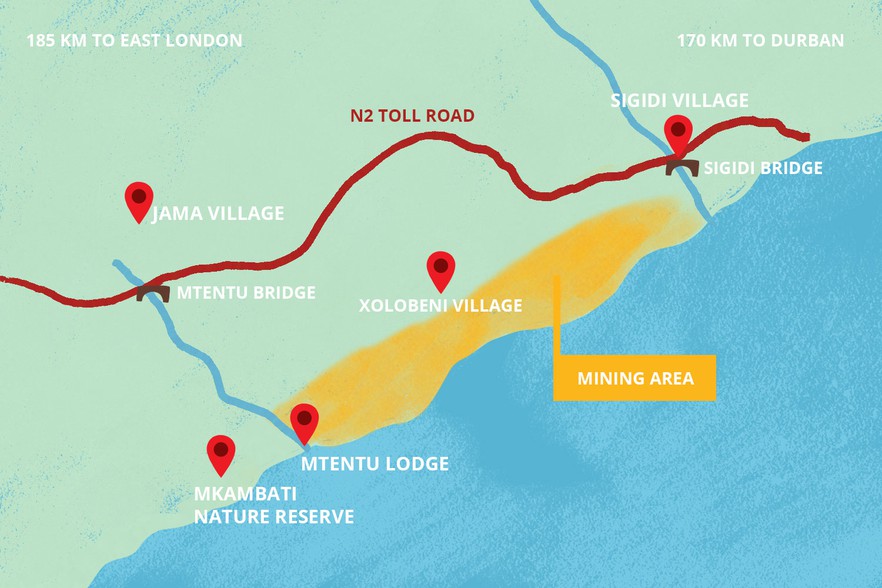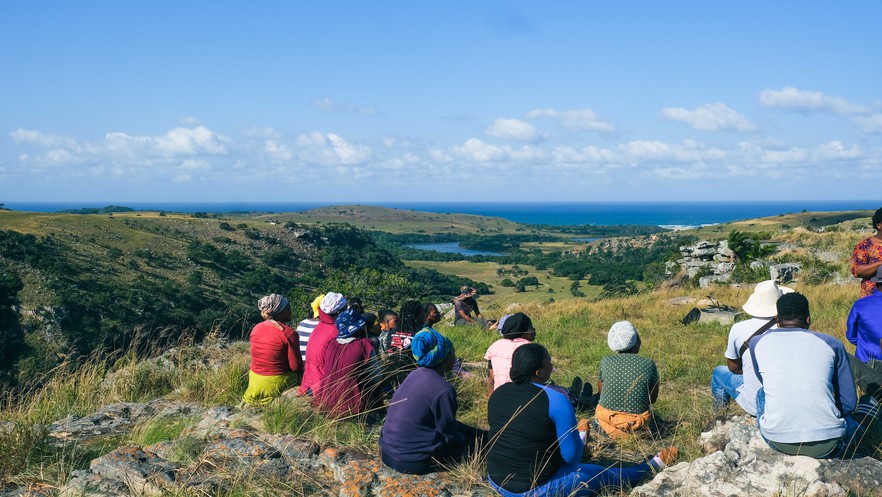Should the proposed N2 toll road through the Wild Coast be moved?
Dispute between SANRAL and Amadiba Crisis Committee looks set to escalate
The proposed N2 Toll Road will cut through Sigidi village. Map: Lisa Nelson
The long-running dispute in the Amadiba area of the Eastern Cape over the planned N2 Toll Road through the Wild Coast shows no sign of calming down.
On one side is the SA National Roads Agency (SANRAL), and on the other the Amadiba Crisis Committee (ACC). This committee was founded to resist the proposed Xolobeni sand mine and is made up of people from Amadiba’s coastal region, which is called Umgungundlovu. The ACC doesn’t want the road to run through Umgungundlovu and says the road should be moved 10km from the coast. Here, we explain what the battle is all about.
Where will the road go?
The road will run from East London, to Port Edward, over 410 km. The current plan is for it to cross the Umgungundlovu area, cutting through Sigidi village.
What is the purpose of the road?
According to SANRAL, the new road will shorten the current N2 by 85 km, save the economy R1.5 billion a year, create 8,000 direct jobs during construction and up to 20,000 indirect jobs, and bring economic development and access to markets for people in the area. SANRAL says under/over passes will be provided at regular intervals, and safe interchanges, and improved local access roads will increase accessibility, mobility and connectivity.
SANRAL says the proposed route through Sigidi only affects a limited area of grazing land and “does not affect any ploughed fields”. Also, a biodiversity offset programme is planned to create over 15,000 hectares of new protected areas. The road will thus create new opportunities for eco-tourism, adventure tourism and conventional tourism, SANRAL says.
Why doesn’t the ACC want it?
The ACC does not object to the building of the whole road, but does not want it to run through the Umgungundlovu area. And, according to the ACC, because the land in Umgungundlovu is communal, the decision to approve the route should be made according to customary law.
The ACC says the community supports sustainable developments such as ecotourism and agriculture, rather than top-down developments such as mines and toll roads. They say the road as planned will divide the community, threaten the livelihoods of community members, bring unwanted development, threaten the current use of communal land for subsistence farming, and destroy the sustainable ecotourism in the area.
When was the road approved?
The road was first planned in 1978. The current planned route was approved by the Department of Environmental Affairs in 2009. Amadiba residents appealed against this in the Pretoria High Court, but the court upheld the plan and commended SANRAL on its public participation process.
Areas of the road are already under construction, although construction has been halted in some places over labour and procurement disputes.
SANRAL says the road and its current route have been approved by all relevant traditional leaders. The ACC disagrees that customary law has been followed.
What does the law say?
The Interim Protection of Informal Land Rights Act (IPILRA) says that where land is communally held, any decision to deprive residents of their land rights must be made according to the customs of the area. Land issues in Amadiba are governed by customary law.
SANRAL says it has followed customary law, consulting with the Amadiba traditional council chief (iNkosi) Lunga Baleni, and with elected ward councillors and politicians, and following the guidance of the Department of Traditional Affairs. IPILRA is followed during land acquisition, SANRAL says.
But the ACC says that according to customary law, the authority to approve developments that affect land rights lies with the people who live on the land, not with the leaders.
They say the decision about whether or not the road should go through Umngungundlovu must be made at the Umgungundlovu Komkhulu (“Great Place”) a traditional court where the community meets to discuss matters and make decisions that affect the community.
Moreover, the ACC says that the Amadiba traditional council has been in crisis since Baleni was made a director of the company which has applied to mine the sands on the coast. Baleni opposed the ACC’s legal battle against the sand mine. The ACC says SANRAL engages with business people, politicians, and traditional leaders who are part of the mining lobby and will profit from the road.
ACC spokesperson Nonhle Mbuthuma travels with a bodyguard after receiving death threats from supporters of the road in 2020. SANRAL says it works with legitimate stakeholders and says it encourages its partners not to engage in intimidatory or violent tactics.
What’s happening in Sigidi village?
Sigidi village has been one of the only villages in Amadiba to resist the signing of a community access agreement with SANRAL. Community access agreements allow SANRAL to survey the area, which involves engaging with residents and installing beacons.
The ACC says any such agreement for Sigidi must be discussed at the Umgungundlovu Komkhulu. ACC says the agreements and installation of beacons amount to depriving residents of land protected by IPILRA.
SANRAL says that community access agreements are not mandatory in law and were implemented by SANRAL as a transparency measure, and therefore IPILRA is not relevant. Community access agreements are generally signed by the traditional leader, in this case Lunga Baleni and the elected ward councillor after a community meeting. SANRAL says the Umgungundlovu Komkhulu is remote, 26 km from Sigidi, and a meeting within Sigidi is more accessible to residents.
On 10 September, a meeting in Sigidi held by the Eastern Cape MEC of public works Babalo Madikizela ended with police using teargas to break up a fight between supporters and opponents of the road. People on both sides who do not live in Sigidi were bussed to the meeting from neighbouring areas.
A smaller stakeholder meeting later in the day went ahead. It was unclear at the time whether a community access agreement had been signed. SANRAL told GroundUp in October that it had been signed but could not provide us with a copy of the agreement.
SANRAL says its attempts to engage with residents in October were disrupted by the ACC.
Which Komkhulu is the right one?
Both SANRAL and ACC accuse one another of ignoring resolutions at the Dangeni Komkhulu, which presides over land issues for the inland region of Amadiba.
SANRAL says that they have met leaders and stakeholders, including the ACC, at the Dangeni Komkhulu and have obtained consent for the road to be built as currently planned.
The ACC says they are not aware of such a resolution and their requests to SANRAL for a record of the resolution were ignored. SANRAL could not provide GroundUp with records of the resolution.
The ACC also accuses SANRAL of ignoring a decision at the Dangeni Komkhulu that work on the toll road would halt until a consensus over the route is reached and also maintains that the decision should be made at the Umgungundlovu komkhulu, not Dangeni.
How many people in Amadiba support the road?
It is unclear whether supporters of the road are in the majority. A 2011 survey of the communities along the route between Port St Johns and Port Edward, conducted by the Human Science Research Council, showed that 98% of residents supported the development.
About 2,300 residents took part in the study, about 240 from each area along the route. Approximately 22,500 people live in Amadiba alone. But the survey was conducted a decade ago before many of the events in the Xolobeni mine saga took place. Mining rights were revoked in 2011 and re-applied for in 2016.
There are a total of 107 households in Sigidi, with on average 15 people per household, the ACC says.
According to preliminary aerial surveys conducted by SANRAL, four homesteads in Sigidi are within or just next to the road reserve and the land of six other households would also be affected. SANRAL says very few people outside the ACC oppose the road, and that some ACC members even support the road, but the ACC says this support is not for the current route through Umgungundlovu.
Is there an alternative route?
The ACC says that the original plan to take the road 10km from the coast, is feasible and should be adopted. SANRAL says it is not feasible.
SANRAL says that there are no suitable bridge sites along the original route and more people would be displaced than would be along the current route. It says an environmental impact assessment in 2008-09 confirmed this.
The ACC says the EIA made no findings against an inland route and SANRAL has not shown any evidence why this route could not work. Experts employed by the ACC are compiling a proposal for an alternative route.
Could it still be moved?
SANRAL says no-one in government or the community has the legal authority to move or block a route approved through a proper legal process.
The ACC says this is untrue. “SANRAL could decide to move the route. Yes, this would require a new environmental authorisation from the Department of Environmental Affairs. But that does not mean a new route is impossible,” the ACC says.
Members of the Amadiba Crisis Committee hold a meeting at the site where a bridge for SANRAL’s N2 toll road is planned. Archive photo: Daniel Steyn
Support independent journalism
Donate using Payfast

Don't miss out on the latest news
We respect your privacy, and promise we won't spam you.
Next: Local manufacture of army’s new uniforms will create jobs
Previous: Neither here nor there: South Africa’s undocumented children
© 2021 GroundUp. This article is licensed under a Creative Commons Attribution-NoDerivatives 4.0 International License.
You may republish this article, so long as you credit the authors and GroundUp, and do not change the text. Please include a link back to the original article.
We put an invisible pixel in the article so that we can count traffic to republishers. All analytics tools are solely on our servers. We do not give our logs to any third party. Logs are deleted after two weeks. We do not use any IP address identifying information except to count regional traffic. We are solely interested in counting hits, not tracking users. If you republish, please do not delete the invisible pixel.


